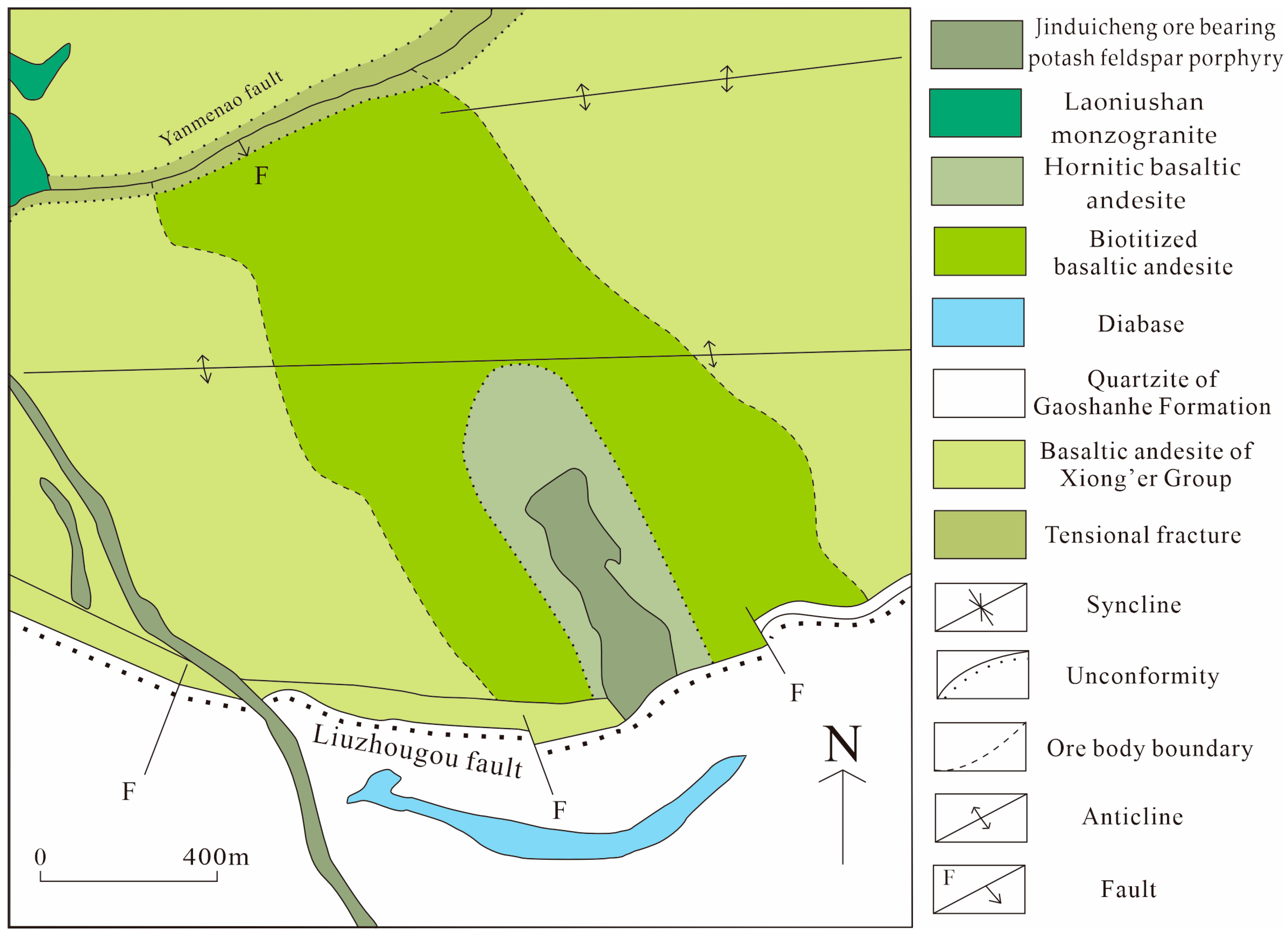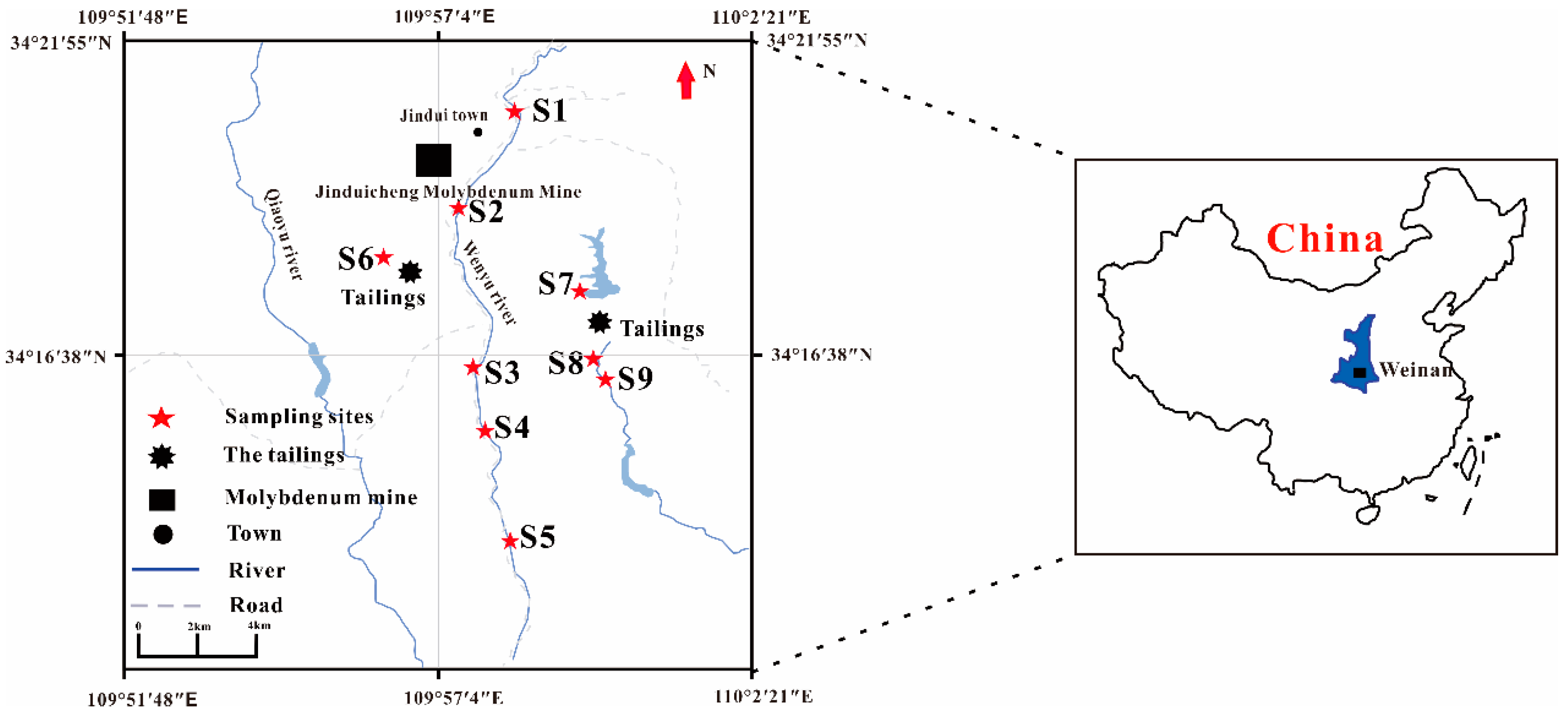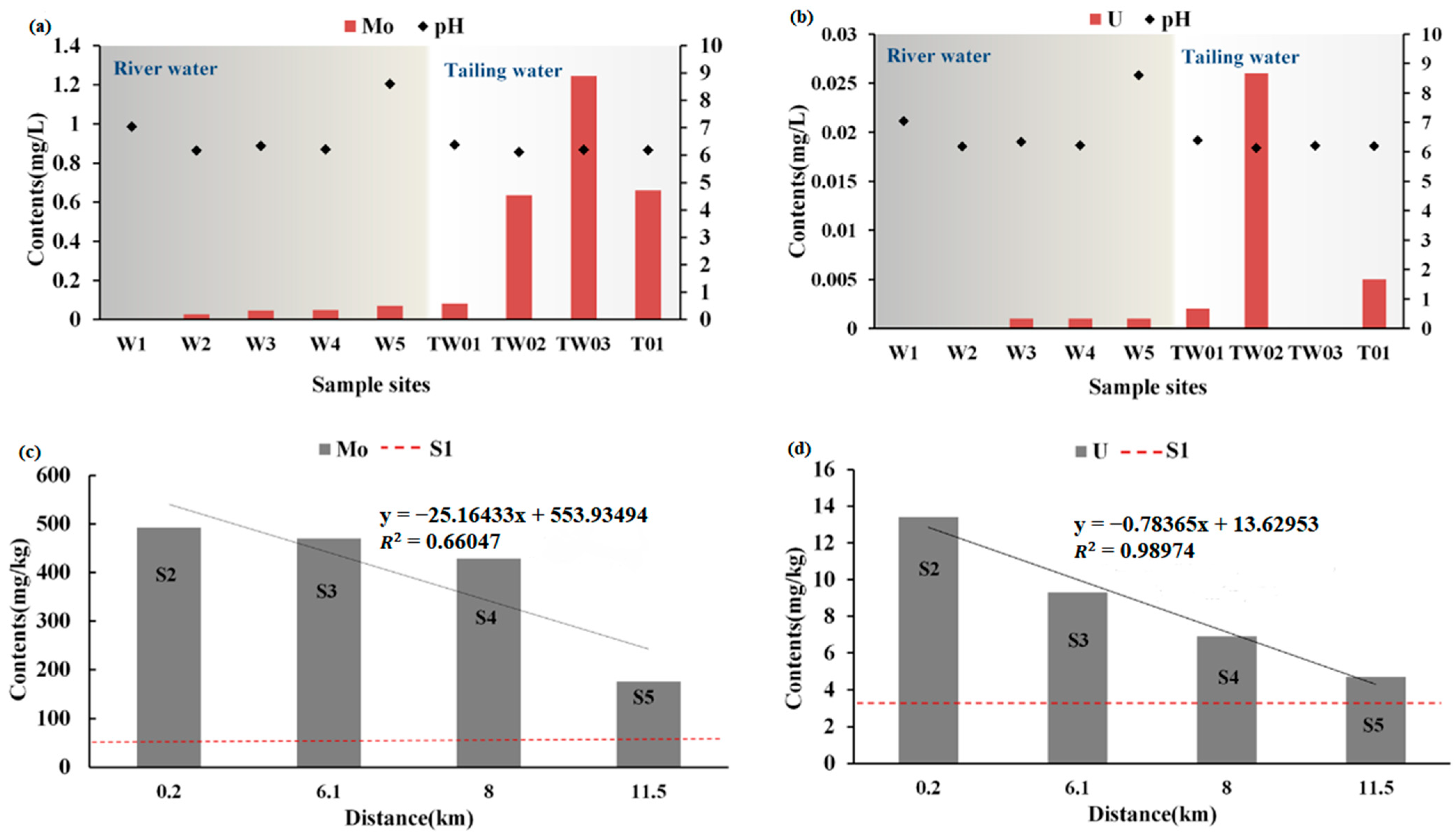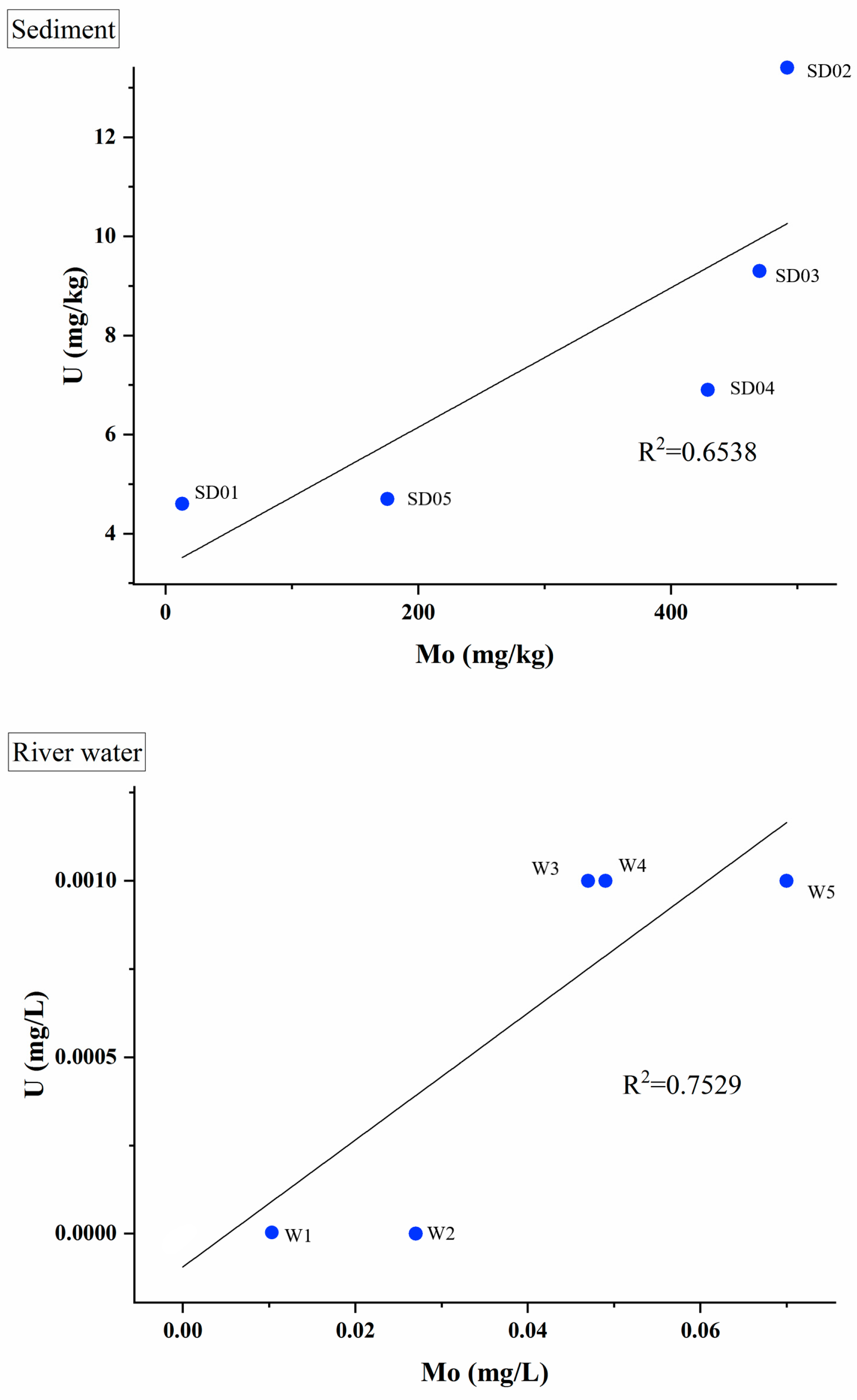Distribution of Uranium and Molybdenum in River Sediment near Molybdenite Mining Region: A Case Study in SW China
Abstract
:1. Introduction
2. Materials and Method
2.1. Study Area Background

2.2. Sampling and Chemical Analysis
2.3. Sample Details
2.4. Processing and Calculative Methods
3. Results and Discussions
3.1. Mo and U Enrichment in Surface Water
3.2. Distribution of U and Mo in Downstream Sediment
3.3. Migration of U and Mo Downstream
4. Conclusions
Author Contributions
Funding
Data Availability Statement
Conflicts of Interest
References
- Pertsemli, E.; Voutsa, D. Distribution of Heavy Metals in Lakes Doirani and Kerkini, Northern Greece. J. Hazard. Mater. 2007, 148, 529–537. [Google Scholar] [CrossRef]
- Wang, X.; Shi, Z.; Ni, S.; Xu, W.; Wang, R. Geochemical Factors Affecting Chronological Reconstruction of a Historical Arsenic Pollution Accident in Lake Qionghai, Southwest of China. Aquat. Ecosyst. Health Manag. 2017, 20, 457–464. [Google Scholar]
- Shi, Z.; Wang, X.; Ni, S. Metal Contamination in Sediment of One of the Upper Reaches of the Yangtze River: Mianyuan River in Longmenshan Region, Southwest of China. Soil Sediment Contam. Int. J. 2015, 24, 368–385. [Google Scholar] [CrossRef]
- Lin, L.; Li, C.; Yang, W.; Zhao, L.; Liu, M.; Li, Q.; Crittenden, J.C. Spatial Variations and Periodic Changes in Heavy Metals in Surface Water and Sediments of the Three Gorges Reservoir, China. Chemosphere 2020, 240, 124837. [Google Scholar] [CrossRef]
- Yuan, P.; Wu, X.; Xia, Y.; Peng, C.; Tong, H.; Liu, J.; Jiang, L.; Wang, X. Spatial and Seasonal Variations and Risk Assessment for Heavy Metals in Surface Sediments of the Largest River-Embedded Reservoir in China. Environ. Sci. Pollut. Res. 2020, 27, 35556–35566. [Google Scholar] [CrossRef] [PubMed]
- Zhang, Y.; Zhang, H.; Zhang, Z.; Liu, C.; Sun, C.; Zhang, W.; Marhaba, T. pH Effect on Heavy Metal Release from a Polluted Sediment. J. Chem. 2018, 2018, 7597640. [Google Scholar] [CrossRef]
- Kelderman, P.; Osman, A.A. Effect of Redox Potential on Heavy Metal Binding Forms in Polluted Canal Sediments in Delft (The Netherlands). Water Res. 2007, 41, 4251–4261. [Google Scholar] [CrossRef]
- Li, H.; Ye, H.; Wang, X.; Yang, L.; Wang, X. Geology and Ore Fluid Geochemistry of the Jinduicheng Porphyry Molybdenum Deposit, East Qinling, China. J. Asian Earth Sci. 2014, 79, 641–654. [Google Scholar] [CrossRef]
- Li, X.; Zhang, Y. Pollution of solid waste from Jinduicheng Molybdenum Mine to water environment. Ground Water 2006, 64–66. [Google Scholar]
- Drygiannaki, I.; Bejar, M.; Reible, D.D.; Dawson, J.A.; Rao, B.; Hayman, N.T.; Rosen, G.H.; Colvin, M.A. Assessing Biota Accumulation Due to Contamination of Sediments by Storm Water Heavy Metals. Environ. Toxicol. Chem. 2020, 39, 2475–2484. [Google Scholar] [CrossRef]
- Beck, M.; Dellwig, O.; Fischer, S.; Schnetger, B.; Brumsack, H.J. Trace Metal Geochemistry of Organic Carbon-Rich Watercourses Draining the NW German Coast. Estuar. Coast. Shelf Sci. 2012, 104, 66–79. [Google Scholar] [CrossRef]
- Groenenberg, J.E.; Römkens, P.F.A.M.; Comans, R.N.J.; Luster, J.; Pampura, T.; Shotbolt, L.; Tipping, E.; De Vries, W. Transfer Functions for Solid-Solution Partitioning of Cadmium, Copper, Nickel, Lead and Zinc in Soils: Derivation of Relationships for Free Metal Ion Activities and Validation with Independent Data. Eur. J. Soil Sci. 2010, 61, 58–73. [Google Scholar] [CrossRef]
- Liu, B.; Sun, H.; Peng, T.; Duan, T. Transport and Transformation of Uranium and Heavy Metals from Uranium Tailings under Simulated Rain at Different pH. Environ. Chem. Lett. 2020, 18, 495–503. [Google Scholar] [CrossRef]
- Guo, B.; Zhu, L.; Li, B.; Xu, J.; Wang, J.; Gong, H. Isotope and Elemental Geochemistry of Jinduicheng Large Porphyry Molybdenum Deposit, East Qinling. Miner. Depos. 2009, 28, 265–281. [Google Scholar]
- Yuan, H.; Wang, R.; Li, W.; Ding, K.; Qin, T. Geological characteristics of Jinduicheng super-large porphyry molybdenum deposit and its new discovery in prospecting. Northwestern Geol. 2016, 49, 172–184. [Google Scholar]
- Bjørklund, G.; Semenova, Y.; Pivina, L.; Dadar, M.; Rahman, M.M.; Aaseth, J.; Chirumbolo, S. Uranium in Drinking Water: A Public Health Threat. Arch. Toxicol. 2020, 94, 1551–1560. [Google Scholar] [CrossRef]
- Wang, X.; Shi, Z.; Kinniburgh, D.G.; Zhao, L.; Ni, S.; Wang, R.; Hou, Y.; Cheng, K.; Zhu, B. Effect of Thermodynamic Database Selection on the Estimated Aqueous Uranium Speciation. J. Geochem. Explor. 2019, 204, 33–42. [Google Scholar] [CrossRef]
- Wang, X.; Ni, S.; Shi, Z. Uranium Distribution in the Sediment of the Mianyuan River near a Phosphate Mining Region in China and the Related Uranium Speciation in Water. Geochemistry 2014, 74, 661–669. [Google Scholar] [CrossRef]
- Yi, L.; Gao, B.; Liu, H.; Zhang, Y.; Du, C.; Li, Y. Characteristics and Assessment of Toxic Metal Contamination in Surface Water and Sediments Near a Uranium Mining Area. Int. J. Environ. Res. Public Health 2020, 17, 548. [Google Scholar] [CrossRef]
- Beck, M.; Dellwig, L.; Schnetger, B.; Brumsack, H.-J. Cycling of Trace Metals (Mn, Fe, Mo, U, V, Cr) in Deep Pore Waters of Intertidal Flat Sediments. Geochim. Cosmochim. Acta 2008, 72, 2822–2840. [Google Scholar] [CrossRef]
- Yang, Q.; Zhang, X.; Hua, C.; Xuan, P. Trace element geochemical characteristics of molybdenite in Dawangshan tungsten molybdenum polymetallic ore concentration area, central Jiangxi. Miner. Petrol. 2018, 38, 59–69. [Google Scholar]
- Sun, Y. Mineralogy and Geochemical Characteristics of Jinduicheng Porphyry Molybdenum Deposit, Shaanxi Province. Master’s Thesis, China University of Geosciences, Beijing, China, 2017. [Google Scholar]
- Kayzar, T.M.; Villa, A.C.; Lobaugh, M.L.; Gaffney, A.M.; Williams, R.W. Investigating Uranium Distribution in Surface Sediments and Waters: A Case Study of Contamination from the Juniper Uranium Mine, Stanislaus National Forest, CA. J. Environ. Radioact. 2014, 136, 85–97. [Google Scholar] [CrossRef]
- Zhang, J.; Sui, X.; Wang, Y. Analysis on exploitation of molybdenum resources in Jinduicheng. China Molybdenum Ind. 2005, 18–22. [Google Scholar] [CrossRef]
- A Global Overview of National Regulations and Standards for Drinking-Water Quality. Available online: https://www.who.int/publications-detail-redirect/9789241513760 (accessed on 27 April 2023).
- Li, X. Geochemical characteristics and preliminary analysis of metallogenic conditions of Jinduicheng-Huanglongpu molybdenum ore field. Geol. Explor. 1983, 59–64. [Google Scholar]
- Huang, D.; We, D.; Nie, F. Geological characteristics and genesis of Jinduicheng Porphyry key deposit in Shaanxi Province. Miner. Depos. 1987, 3. [Google Scholar] [CrossRef]
- Chen, H. Heavy Metal Migration in Tailings Reservoir under Rainfall and Vegetation Conditions. Master’s Thesis, Liaoning University, Shenyang, China, 2022. [Google Scholar]
- Goldberg, S. Modeling Selenate Adsorption Behavior on Oxides, Clay Minerals, and Soils Using the Triple Layer Model. Soil Sci. 2014, 179, 568–576. [Google Scholar] [CrossRef]
- Wang, X.; Sherman, D.M. Molecular Speciation of Mo (VI) on Goethite and Its Implications for Molybdenum and Its Isotopic Cycle in Ocean. Geochim. Cosmochim. Acta 2021, 313, 116–132. [Google Scholar] [CrossRef]
- Zhao, Z. Adsorptive Stripping Voltammetry Determination of Molybdenum (VI) in Water and Soil. Talanta 1990, 37, 1007–1010. [Google Scholar] [CrossRef]
- Cheng, H.; Li, K.; Li, M.; Yang, K.; Liu, F.; Cheng, X. Background and baseline values of chemical elements in urban soil of China. Earth Sci. Front. 2014, 21, 265–306. [Google Scholar] [CrossRef]
- Martin, J.-M.; Meybeck, M. Elemental Mass-Balance of Material Carried by Major World Rivers. Mar. Chem. 1979, 7, 173–206. [Google Scholar] [CrossRef]
- Yu, R.; Yuan, X.; Zhao, Y.; Hu, G.; Tu, X. Heavy Metal Pollution in Intertidal Sediments from Quanzhou Bay, China. J. Environ. Sci. 2008, 20, 664–669. [Google Scholar] [CrossRef] [PubMed]
- Barnett, M.O.; Jardine, P.M.; Brooks, S.C.; Selim, H.M. Adsorption and Transport of Uranium (VI) in Subsurface Media. Soil Sci. Soc. Am. J. 2000, 64, 908–917. [Google Scholar] [CrossRef]
- Huang, G.; Wu, D.; Huang, G.; Xue, W.; Min, Z.; Fan, P. Provenance of Jurassic Sediments from Yuqia Sandstone-Type Uranium Deposits in the Northern Margin of Qaidam Basin, China and Its Implications for Uranium Mineralization. Minerals 2022, 12, 82. [Google Scholar] [CrossRef]
- Swarzenski, P.W.; McKee, B.A. Seasonal Uranium Distributions in the Coastal Waters off the Amazon and Mississippi Rivers. Estuaries 1998, 21, 379–390. [Google Scholar] [CrossRef]
- Andersson, P.S.; Porcelli, D.; Gustafsson, Ö.; Ingri, J.; Wasserburg, G.J. The Importance of Colloids for the Behavior of Uranium Isotopes in the Low-Salinity Zone of a Stable Estuary. Geochim. Cosmochim. Acta 2001, 65, 13–25. [Google Scholar] [CrossRef]
- Swarzenski, P.W.; McKee, B.A.; Booth, J.G. Uranium Geochemistry on the Amazon Shelf: Chemical Phase Partitioning and Cycling across a Salinity Gradient. Geochim. Cosmochim. Acta 1995, 59, 7–18. [Google Scholar] [CrossRef]
- Bouchez, J.; Gaillardet, J.; France-Lanord, C.; Maurice, L.; Dutra-Maia, P. Grain Size Control of River Suspended Sediment Geochemistry: Clues from Amazon River Depth Profiles. Geochem. Geophys. Geosyst. 2011, 12, Q03008. [Google Scholar] [CrossRef]
- Karathanasis, A.D.; Johnson, D.M.C. Subsurface Transport of Cd, Cr, and Mo Mediated by Biosolid Colloids. Sci. Total Environ. 2006, 354, 157–169. [Google Scholar] [CrossRef]
- Revels, B.N.; Rickli, J.; Moura, C.A.V.; Vance, D. The Riverine Flux of Molybdenum and Its Isotopes to the Ocean: Weathering Processes and Dissolved-Particulate Partitioning in the Amazon Basin. Earth Planet. Sci. Lett. 2021, 559, 116773. [Google Scholar] [CrossRef]
- Bouchez, J.; Lajeunesse, E.; Gaillardet, J.; France-Lanord, C.; Dutra-Maia, P.; Maurice, L. Turbulent Mixing in the Amazon River: The Isotopic Memory of Confluences. Earth Planet. Sci. Lett. 2010, 290, 37–43. [Google Scholar] [CrossRef]
- Raji, I.B.; Hoffmann, E.; Ngie, A.; Winde, F. Assessing Uranium Pollution Levels in the Rietspruit River, Far West Rand Goldfield, South Africa. Int. J. Environ. Res. Public Health 2021, 18, 8466. [Google Scholar] [CrossRef]
- Bachhav, M.; Miller, B.; Gan, J.; Keiser, D.; Leenaers, A.; Van den Berghe, S.; Meyer, M.K. Microstructural Changes and Chemical Analysis of Fission Products in Irradiated Uranium-7 Wt.% Molybdenum Metallic Fuel Using Atom Probe Tomography. Appl. Sci. 2021, 11, 6905. [Google Scholar] [CrossRef]
- Liao, J.; Qian, X.; Liu, F.; Deng, S.; Lin, H.; Liu, X.; Wei, C. Multiphase Distribution and Migration Characteristics of Heavy Metals in Typical Sandy Intertidal Zones: Insights from Solid-Liquid Partitioning. Ecotoxicol. Environ. Saf. 2021, 208, 111674. [Google Scholar] [CrossRef] [PubMed]
- Sauve, S.; Manna, S.; Turmel, M.C.; Roy, A.G.; Courchesne, F. Solid-Solution Partitioning of Cd, Cu, Ni, Pb, and Zn in the Organic Horizons of a Forest Soil. Environ. Sci. Technol. 2003, 37, 5191–5196. [Google Scholar] [CrossRef] [PubMed]
- Shi, Z.; Wang, X.; Shi, Y.; Ni, S.; Li, Y.; Wang, D.; Wang, R. Impact of Intensive Mining on the Distribution of Heavy Metals in Water and Sediment of Anning River, Southwest China. GEEA 2019, 19, 24–30. [Google Scholar] [CrossRef]




| Site | Parameters | Electric Conductivity (μS/cm) | Sampling Description | |
|---|---|---|---|---|
| pH | Eh (mV) | |||
| S1 | 7.04 | 8 | 150 | S1 was located by the Wenyu River. The surface water (W1) and river sediment sample (SE1) of Wenyu River were collected at S1. |
| S2 | 6.18 | 52 | 270 | S2 was located on the river course. The surface water (W2), river sediments (SE2) and soil on the banks of the river (S02) were collected at S2. |
| S3 | 6.34 | 35 | 300 | S3 was located by the river with visible domestic waste. Surface water (W3), river sediment (SE3), and farmland soil (S03) were collected at S3. The soil sample(S03) was 10 m away from the river bank. |
| S4 | 6.21 | 35 | 320 | Domestic garbage and smelly silt could be seen at S4 sampling site. River water (W4) and river sediment (SE4) were collected at S4. |
| S5 | 8.6 | −77 | 350 | S5 was located by the river, and the sediments in the river contained high levels of humus. River water (W5) and river sediment (SE5) were collected at S5. |
| S6 | 6.38 | 28 | 170 | S6 was located in the tailing pond in the southwest of the molybdenite, with a few herbs. Tailing water sample (TW01) was collected at S6. |
| S7 | 6.12 | 51 | 1240 | S7 was located on the north side of the tailing pond in the southeast of the molybdenite mine. The tailing pond water (TW02) was collected. Fish could be seen in the water. |
| S8 | 6.2 | 48 | 1090 | S8 was located in the tailings pond in the southeast. Mainly collected drainage samples of tailing pond (TW03). |
| S9 | 6.19 | 52 | 940 | S9 was located in the creek downstream of the tailing pond in the southeast. Collected water samples (T01) of the drainage channel of the mine and soil samples (TS01) by the creek. |
| Extraction Step | Extractant | T (°C) | pH | Incubation Time (Hours) |
|---|---|---|---|---|
| weak-acid soluble | 40 mL 0.11 mol·L−1 HAc | 25 °C | 16 | |
| reducible | 40 mL 0.1 mol·L−1 HONH3Cl | 25 °C | 2 | 16 |
| oxidizable | (a) 10 mL 30% H2O2 | 85 °C | heat to dryness | |
| (b) 50 mL 1 mol·L−1 NH4OAc | 25 °C | 16 | ||
| residual | 10 mL HNO3, 10 mL HF, 3 mL HClO4 | 25 °C | 1 | |
| 1 mL V(HNO3):V(H2O) = 1:1 | cool down |
| Sediments | River Water | Tailing Water | ||||
|---|---|---|---|---|---|---|
| Mo | U | Mo | U | Mo | U | |
| S1 | 13.2 | 4.60 | <0.001 | <0.001 | - | - |
| S2 | 492 | 13.40 | 0.027 | <0.001 | - | - |
| S3 | 470 | 9.30 | 0.047 | 0.001 | - | - |
| S4 | 429 | 6.90 | 0.049 | 0.001 | - | - |
| S5 | 175.5 | 4.70 | 0.070 | 0.001 | - | - |
| S6 | - | - | - | - | 0.083 | 0.002 |
| S7 | - | - | - | - | 0.635 | 0.026 |
| S8 | - | - | - | - | 1.245 | <0.001 |
| S9 | - | - | - | - | 0.660 | 0.005 |
| Total | 1579.7 | 38.9 | 0.193 | 0.003 | 2.62 | 0.03 |
| Min | 13.2 | 4.6 | 0 | 0 | 0.08 | 0 |
| Max | 492 | 13.4 | 0.07 | 0.001 | 1.25 | 0.03 |
| Mean | 315.94 | 7.78 | 0.039 | 0.001 | 0.66 | 0.01 |
| S.D. | 211.476 | 3.683 | 0.026 | 0.001 | 0.47 | 0.01 |
| Median | 429 | 6.9 | 0.047 | 0.001 | 0.65 | 0 |
| RSD (%) | 0.669 | 0.473 | 68.4 | 91.3 | 72 | - |
| Background value | 0.8 a | 2.2 a | 0.02 b | 0.001 c | - | - |
| background value | 13.2 | 4.6 | 0 | 0 | - | - |
| Sample Type | Speciation | Distribution of Various Potentially Toxic Elements | ||
|---|---|---|---|---|
| Mo | U | Mn | ||
| SE1 | F1 | 0.01 | 0.11 | 0.53 |
| F2 | 0.24 | 0.61 | 2.70 | |
| F3 | 7.16 | 0.44 | 7.84 | |
| F4 | 7.24 | 3.25 | 30.74 | |
| SE2 | F1 | 0.01 | 1.59 | 1.30 |
| F2 | 3.30 | 1.49 | 4.02 | |
| F3 | 175.82 | 4.60 | 12.16 | |
| F4 | 253.56 | 3.34 | 42.04 | |
| SE3 | F1 | 1.63 | 2.10 | 8.31 |
| F2 | 4.34 | 1.85 | 2.79 | |
| F3 | 113.51 | 2.87 | 8.98 | |
| F4 | 342.77 | 2.16 | 36.86 | |
| SE4 | F1 | 0.05 | 1.10 | 0.75 |
| F2 | 3.90 | 1.48 | 2.49 | |
| F3 | 98.35 | 2.06 | 8.38 | |
| F4 | 358.41 | 1.92 | 35.35 | |
| SE5 | F1 | 0.03 | 0.24 | 1.17 |
| F2 | 4.53 | 0.79 | 3.80 | |
| F3 | 34.77 | 0.56 | 13.00 | |
| F4 | 157.25 | 2.30 | 56.91 | |
| Speictation | Contents | F1 | F2 | F3 | F4 | |
|---|---|---|---|---|---|---|
| Mo | F1 | 0.424 | 1 | |||
| F2 | 0.72 | 0.357 | 1 | |||
| F3 | 0.862 | 0.231 | 0.457 | 1 | ||
| F4 | 0.974 | 0.47 | 0.77 | 0.724 | 1 | |
| U | F1 | 0.884 | 1 | |||
| F2 | 0.811 | 0.975 | 1 | |||
| F3 | 0.987 | 0.836 | 0.78 | 1 | ||
| F4 | 0.205 | −0.212 | −0.385 | 0.2 | 1 | |
| Sites | Kp(Mo) × 103 | Kp(U) × 103 |
|---|---|---|
| S1 | - | - |
| S2 | 18.2 | - |
| S3 | 10.0 | 9.3 |
| S4 | 8.8 | 6.9 |
| S5 | 2.5 | 4.7 |
Disclaimer/Publisher’s Note: The statements, opinions and data contained in all publications are solely those of the individual author(s) and contributor(s) and not of MDPI and/or the editor(s). MDPI and/or the editor(s) disclaim responsibility for any injury to people or property resulting from any ideas, methods, instructions or products referred to in the content. |
© 2023 by the authors. Licensee MDPI, Basel, Switzerland. This article is an open access article distributed under the terms and conditions of the Creative Commons Attribution (CC BY) license (https://creativecommons.org/licenses/by/4.0/).
Share and Cite
Zhang, H.; Wang, X.; Wang, H.; Yin, J.; Wang, R.; Shi, Z.; Ni, S. Distribution of Uranium and Molybdenum in River Sediment near Molybdenite Mining Region: A Case Study in SW China. Minerals 2023, 13, 1435. https://doi.org/10.3390/min13111435
Zhang H, Wang X, Wang H, Yin J, Wang R, Shi Z, Ni S. Distribution of Uranium and Molybdenum in River Sediment near Molybdenite Mining Region: A Case Study in SW China. Minerals. 2023; 13(11):1435. https://doi.org/10.3390/min13111435
Chicago/Turabian StyleZhang, Hang, Xinyu Wang, Hangjia Wang, Jinfan Yin, Ruilin Wang, Zeming Shi, and Shijun Ni. 2023. "Distribution of Uranium and Molybdenum in River Sediment near Molybdenite Mining Region: A Case Study in SW China" Minerals 13, no. 11: 1435. https://doi.org/10.3390/min13111435
APA StyleZhang, H., Wang, X., Wang, H., Yin, J., Wang, R., Shi, Z., & Ni, S. (2023). Distribution of Uranium and Molybdenum in River Sediment near Molybdenite Mining Region: A Case Study in SW China. Minerals, 13(11), 1435. https://doi.org/10.3390/min13111435






